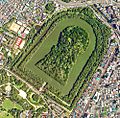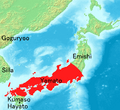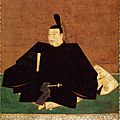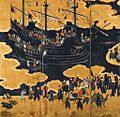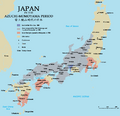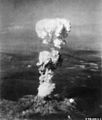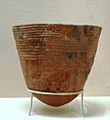History of Japan facts for kids
Japan's history goes back thousands of years, even before written records. Scientists have found signs of people living there since the end of the last Ice Age. Written history began around the 1st century.
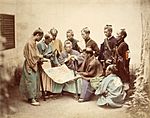 History of Japan |
|---|
|
Contents
- Japan's Earliest Times
- Ancient and Classical Japan
- Feudal Japan: Rule by Warriors
- Meiji Restoration: Modernizing Japan
- World War I to End of World War II
- Occupied Japan: Rebuilding and Change
- Post-Occupation Japan: Economic Growth
- Political Life: A New Democracy
- Modern Life: The Heisei Era
- Images for kids
- See also
Japan's Earliest Times
Before people started writing things down, Japan had a long "prehistory." Archeologists have found old pottery and tools from this time. Japan's Stone Age, called the Paleolithic era, lasted from about 100,000 BC to 12,000 BC. Some stone tools found are over 32,000 years old and are kept in the Tokyo National Museum.
The Jomon Period: Ancient Potters
The Jomon period lasted for about 10,000 years, from 10,000 BC to 300 BC. During this time, people in Japan made amazing pottery. Some experts think they were the first people in the world to create pottery! Archeologists have found many clay figures and different shaped pots from this period.
The Yayoi Period: Rice and Villages
The Yayoi period lasted about 550 years, from 300 BC to 250 AD. This period is named after a place in Tokyo where important discoveries were made.
During the Yayoi period, Japanese people learned how to grow rice. Farming became very important to their way of life. This also led to people having different social statuses.
Different groups, called clans, controlled various areas and sometimes fought each other. Old Chinese writings talk about Japan during this time, calling it "Wa." Later, around 30 smaller groups in Japan joined together to form the Yamatai kingdom, led by a queen named Himiko.
Ancient and Classical Japan
This long period covers about 900 years, from the mid-3rd century to the end of the 12th century. It can be divided into several smaller periods.
Kofun Period: Giant Tombs and New Ideas
The Kofun period lasted from the mid-3rd century to the mid-6th century. This era is famous for huge burial mounds called Kofun. Important leaders were buried in these tombs. Many kofuns were built across the country, showing that powerful groups were forming. This eventually led to the rise of the Yamato dynasty.
The Yamato dynasty started to interact more with Korea and China. In the 4th century, they went to Korea to get iron. This brought new cultures and technologies from Korea and China to Japan. They also fought with Goguryeo and Silla, which were kingdoms in Korea. In the 5th century, five kings from Japan tried to build stronger ties with China.
Asuka Period: Buddhism Arrives
The Asuka period lasted from the mid-6th century to around 710 AD. It's named after the area where the Yamato dynasty had its main base. During this time, Buddhism arrived in Japan.
In the late 6th and early 7th centuries, Empress Suiko and her nephew Prince Shotoku worked to make the emperor more powerful. They also sent groups to learn from the Sui dynasty in China.
Japan continued to centralize its power. In 645, the Taika Reforms brought big changes to the political system.
In 663, Japan fought the Tang dynasty and Silla in the Battle of Baekgang but lost.
In 672, the Jinshin War took place, and Prince Ōama became Emperor Tenmu. During his rule, Japan started to create a Chinese-style law system called Ritsuryo. Also, the word "nihon" or "nippon" ("日本"), meaning "Japan," began to be used.
Nara Period: A New Capital City
From 707 AD, plans were made to move the capital to Heijō-kyō, near today's Nara. This new city was finished in 710 AD. It was built to look like Chang'an (now Xi'an), the capital of China's Tang Dynasty at that time.
Development was slow during the Nara period. The Emperor's family often fought with Buddhists and other groups for power. Japan had good relationships with Korea and China's Tang Dynasty. The capital was moved twice more: to Nagaoka in 784 and then to Kyoto in 794.
Heian Period: Golden Age of Culture
The years from 794 to 1185 are called the Heian period (平安時代, Heian jidai). This period is named after Heian-kyō, the old name for Kyoto. The Heian period was a time of great cultural achievements. For example, Murasaki Shikibu wrote The Tale of Genji, one of the world's first novels. The Heian Period ended because of the Genpei War.
Feudal Japan: Rule by Warriors
The period from the 12th century to the 19th century is known as feudal Japan. The Japanese Emperor was the official head of the government, but he didn't have much real power. Instead, powerful families called daimyo and military leaders called shogun ruled Japan. This feudal period is divided into different parts, named after the shogunate that was in charge.
Kamakura Period: The First Shogunate
The years 1185 to 1333 are known as the Kamakura period (鎌倉時代, Kamakura jidai). This period is named after Kamakura, which was the center of power for the Kamakura shogunate. Minamoto no Yoritomo was the founder and first shogun of this military government.
Muromachi Period: New Contacts
The Muromachi Period began in 1336 and ended in 1573. During this time, the Ashikaga shogunate took control of most of Japan. This period ended when the last shogun, Ashikaga Yoshiaki, was forced to leave Kyoto in 1573.
In 1542, a Portuguese ship reached Japan, marking the first direct contact between Japan and Europe. This brought new things like firearms. Over the next few years, merchants and Christian missionaries from European countries like Portugal, the Netherlands, England, and Spain also arrived in Japan.
Azuchi-Momoyama Period: Unifying Japan
The Azuchi-Momoyama period covers the years from 1568 to 1600. During this time, different parts of Japan became united again, and Japan's military power grew. In 1592, Toyotomi Hideyoshi, a powerful leader, wanted to conquer China, which was ruled by the Ming dynasty. He sent an army of 160,000 samurai to Korea. The Japanese did not win and went back to Japan. In 1597, Japan sent another army to Korea. When Toyotomi Hideyoshi died in 1598, Japan gave up the idea of conquering Korea and China.
During this period, many Koreans were brought to Japan. These Koreans were skilled in pottery and other arts, and they brought new knowledge to Japan.
Edo Period: Peace and Isolation

During the Edo period, Japan had many small rulers called daimyo, but they were all controlled by the Tokugawa Shogunate. The Tokugawa clan led this government, and its capital was in Edo, which is now Tokyo. Fifteen shoguns ruled during the Edo Period.
The Edo period was very important for Japan. Here are some key developments:
- Samurai became the highest group in Japanese society. Farmers, artisans, and merchants were below them.
- Ordinary people were organized into groups of five. If one person made a mistake, all five were responsible.
- New art forms like Ukiyo-e wood-block printing were invented. New types of theater, such as kabuki and bunraku, also became popular.
- Trade and business grew during this time.
In 1867, the Tokugawa Shogunate gave its political power back to the emperor. However, the emperor hadn't had real power for 500 years, so the shogunate still had some authority.
In 1868, the Boshin War happened between the Japanese emperor and the Tokugawa shogunate. The shogunate was defeated, and Japan came back under the direct rule of the emperor.
Japan's Seclusion Policy
Starting in the early 17th century, the Tokugawa shogunate began a policy of seclusion, called sakoku in Japanese. They worried that European traders, merchants, and missionaries wanted to take control of Japan. So, almost all foreigners were forced to leave Japan, except for the Dutch, Koreans, and Chinese.
Even during this time of seclusion, the Japanese still managed to learn about other parts of the world.
End of Seclusion
This policy of seclusion lasted for about 200 years. It ended when American military force arrived. On July 8, 1853, Commodore Matthew Perry of the United States Navy came to Edo with four warships. Their powerful guns were pointed at the city. Because of this show of military strength, Japan was forced to agree to trade with other countries. The Japanese called these ships the kurofune or Black Ships.
The next year, on March 31, 1854, Perry returned with seven ships. The Japanese signed a treaty called the Convention of Kanagawa, which started diplomatic relations with the United States. Another treaty, the Harris Treaty, was signed on July 29, 1858. This treaty made it easier for foreigners to come to Japan and increased trade. Many Japanese people were not happy about reopening relations and trade with other countries.
Meiji Restoration: Modernizing Japan
The Meiji Restoration was a very important time in Japan's history. Emperor Meiji regained power from the shogunate. This period began with the Boshin War in 1868. Emperor Meiji wanted Japan to become more like Western countries. Many big changes happened in Japan's government and culture.
Wars with China and Russia
In the late 19th century, many Japanese believed that Japan needed to grow stronger to stand up to Western powers. This led to wars with its neighbors. Japan fought China in 1894-1895. Another war took place with Russia in 1904-1905. After these wars, Japan became a major world power.
Anglo-Japanese Alliance
By the early 20th century, Russia's influence was growing in China. Japan and the United Kingdom both benefited from their relationship with China and didn't like Russia's growing power there. So, Japan and the United Kingdom formed a military alliance called the Anglo-Japanese Alliance on January 30, 1902. Russia was unhappy about this. Russia tried to form its own alliance with Germany and France. On March 6, 1902, Russia formed an alliance with France, but not Germany.
The Russo-Japanese War began between Japan and Russia. Japan won this war. The United States helped with the peace talks between Japan and Russia. Japan gained several benefits. In 1910, Japan invaded and annexed Korea.
World War I to End of World War II
In 1914, World War I started. Japan joined the war, attacking German colonies in East Asia. After the war ended in 1919, Japan developed very quickly. It became one of Asia's main powers.
World War II: Global Conflict
Before World War II began, Japan was already fighting with China in the Second Sino-Japanese War (1937-1945). When World War II started in 1939, Japan joined forces with Nazi Germany and Fascist Italy. Japanese planes attacked Pearl Harbor on December 7, 1941. The fighting continued for years. When the USA dropped the first atomic bombs on the Japanese cities of Hiroshima and Nagasaki, Japan accepted defeat and surrendered in 1945.
During World War II, Japan also occupied the Philippines. Japanese forces attacked the Clark Air Base in Pampanga on December 8, 1941, and then landed ground troops. The defending Philippine and United States troops fought bravely but were eventually forced to surrender. Many prisoners of war were forced to endure the difficult Bataan Death March. The Japanese set up a new government in the Philippines, but it was not popular. Many Filipinos resisted the occupation through underground and guerrilla activities. The war in the Philippines ended with Japan's formal surrender in September 1945. The Philippines suffered greatly, with many lives lost and widespread destruction.
Occupied Japan: Rebuilding and Change
After World War II, Japan was controlled by international forces. Japan became an important friend to the USA during the Cold War with Korea. Over the next few years, many political, economic, and social changes happened. The Japanese Diet (legislature) was created. In 1951, the USA and 45 other countries signed an agreement with Japan. Japan became a fully independent nation again on April 28, 1952.
Post-Occupation Japan: Economic Growth
"Post-Occupation Japan" refers to the period after Japan was no longer controlled by other nations. World War II had severely damaged Japan, destroying its industries and economy. After the war, Japan received help and technology from the USA and other European countries. Japan's progress was very fast. For about 30 years, from the 1950s to the 1980s, Japan grew rapidly. It became one of the world's major economic powers.
When UN forces fought in the Korean War, Japan was a major supplier, which also helped its economy. By the 1980s, Japan had the world's second-largest economy, after the USA. At first, Japan and the USA had a very close relationship. However, Japan's economic strength led to a trade deficit for the USA, meaning the USA imported more from Japan than it exported.
For various reasons, this period of rapid growth ended in the 1990s. Some historians call this decade the "lost decade" for Japan's economy. Around 5 to 10 out of every 100 people could not find work.
Political Life: A New Democracy
By 1952, Japan was free from most of the controls of the occupation period. It developed its own democratic system. Various political parties were formed, and Japan's political life became very active.
Modern Life: The Heisei Era
Historians and sociologists call the recent era "modern life." In Japanese, this is known as the Heisei period. By 1989, Japan's economy was very large, and much development had taken place. In the Gulf War of 1991, Japan contributed billions of dollars.
Japan also faced some challenges. In 1995, a big earthquake hit Kobe. Another earthquake happened on October 23, 2004, in Niigata Prefecture. A very destructive tsunami damaged the northeast coast in March 2011, causing a nuclear accident in Fukushima Prefecture.
Images for kids
-
Daisenryō Kofun, Osaka
-
Buddhist temple of Horyu-ji is the oldest wooden structure in the world. It was commissioned by Prince Shotoku and represents the beginning of Buddhism in Japan.
-
The word Nihon written in kanji (horizontal placement of characters). The text means "Japan" in Japanese.
-
Prince Shōtoku was a semi-legendary regent of the Asuka period, and considered to be the first major sponsor of Buddhism in Japan.
-
The Daibutsu-den, within the complex of Tōdai-ji. This Buddhist temple was sponsored by the Imperial Court during the Nara period.
-
Miniature model of the ancient capital Heian-kyō
-
A handscroll painting dated c. 1130, illustrating a scene from the "Bamboo River" chapter of The Tale of Genji
-
Minamoto no Yoritomo was the founder of the Kamakura shogunate in 1192. This was the first military government in which the shogun with the samurai were the de facto rulers of Japan.
-
The Black Ship Portuguese traders that came from Goa and Macau once a year.
-
Edo period screen depicting the Battle of Sekigahara. It began on 21 October, 1600, with a total of 160,000 men facing each other. -
Emperor Meiji, the 122nd Emperor of Japan
-
Chinese generals surrendering to the Japanese in the Sino-Japanese War of 1894–1895 -
Planes from the Japanese aircraft carrier Shōkaku preparing the attack on Pearl Harbor
-
General Douglas MacArthur and Emperor of Japan, Hirohito, at their first meeting, September 1945
-
US Secretary of State Dean Acheson signing the Treaty of Peace with Japan, 8 September 1951
-
Shigeru Yoshida was one of the longest serving PMs in Japanese history (1946–1947 and 1948–1954).
-
Wreckage at a railway station destroyed during the 2011 earthquake and tsunami.
-
A vase from the early Jōmon period (11000–7000 BC)
-
Dogū figurine of the late Jōmon period (1000–400 BC)
See also
 In Spanish: Historia de Japón para niños
In Spanish: Historia de Japón para niños



